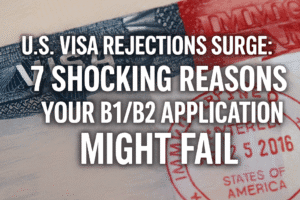U.S. Visa Rejections Surge: 7 Shocking Reasons Your B1/B2 Application Might Fail
Stricter U.S. immigration policies under the Trump administration have led to a sharp rise in B1/B2 visa rejections, with consular officers intensifying scrutiny of applicants’ intent to return home. Central to denials is Section 214(b) of the Immigration Act, which presumes all applicants seek permanent residency unless proven otherwise. Officers now rigorously assess ties to home countries—such as stable jobs, property ownership, or family dependents—to gauge risk of overstaying.
Cases like parents denied visas to visit children studying in the U.S. or families barred from attending events highlight the heightened skepticism. Applicants must provide robust documentation of financial stability, clear travel purposes (e.g., event invitations), and strong domestic commitments. Critics argue the approach risks alienating legitimate travelers, but for now, meticulous preparation and transparent communication during interviews remain critical to overcoming the stringent vetting process. Success hinges on demonstrating deep-rooted connections to one’s home country and a compelling, temporary reason to visit the U.S.

U.S. Visa Rejections Surge: 7 Shocking Reasons Your B1/B2 Application Might Fail
The U.S. B1/B2 visa process has become increasingly daunting for foreign applicants, with rejection rates soaring under heightened immigration scrutiny. Stories of abrupt denials—such as parents barred from visiting their children studying in the U.S. or families prevented from attending milestone events—highlight a shifting landscape where proving non-immigrant intent is more critical than ever. Here’s a breakdown of the challenges and strategies for applicants.
Why Are Visa Rejections Rising?
The Trump administration’s stricter immigration policies have intensified scrutiny on temporary visas. Consular officers now rigorously assess whether applicants have compelling reasons to return home after their U.S. stay. Key factors driving rejections include:
- Weak “Ties” to Home Country: Officers evaluate social, economic, and familial connections—such as stable employment, property ownership, or dependents—to gauge if applicants might overstay. Even minor red flags, like a child transferring universities in the U.S., can trigger suspicion.
- Vague Travel Plans: Applications for events like family gatherings or tourism without detailed itineraries or financial proof are increasingly questioned.
- Previous Visa Issues: Terminations of student visas (SEVIS records) and prior rejections may cast a shadow on new applications, even for unrelated visa categories.
The Legal Hurdle: Section 214(b)
Under the Immigration and Nationality Act (Section 214(b)), all visa applicants are presumed to have immigrant intent until proven otherwise. This places the burden on applicants to demonstrate:
- A permanent home and commitments abroad they won’t abandon.
- A clear, temporary purpose for their U.S. visit (tourism, business meetings, etc.).
- Financial capacity to fund their trip without unauthorized work.
Consular officers often make snap judgments during brief interviews, relying on documentation and responses to assess risk.
Real-World Examples of Denials
- A couple applying to attend their nephew’s graduation in Texas was rejected twice, with officers citing insufficient proof of employment stability in India.
- A retired professional seeking to visit grandchildren in California was denied due to lack of property ownership or familial obligations at home.
- Students’ parents face heightened skepticism, as officers worry they might overstay to support children adjusting to new universities.
How Applicants Can Strengthen Their Case
Document “Roots” Meticulously:
- Provide evidence of employment (leave letters, tax returns), property deeds, or family dependents.
- Retirees should highlight community ties, investments, or recurring responsibilities.
Craft a Clear Travel Narrative:
- Align trips with specific events (weddings, conferences) and submit invitations or registration proofs.
- Avoid vague plans like “touring for months” without structured itineraries.
Address Past Issues Proactively:
- If previously denied, clarify changes in circumstances (e.g., new job, assets) in a follow-up application.
Practice Interview Preparedness:
- Anticipate questions about travel goals, finances, and post-trip plans. Brief, confident answers matter.
The Bigger Picture
While policies aim to curb immigration violations, critics argue the aggressive approach risks harming legitimate travelers and U.S. tourism. Families separated by rejections and missed business opportunities underscore the human and economic toll. For now, applicants must navigate this climate with meticulous preparation, understanding that consular decisions hinge on perceived risk—not just paperwork.
In an era where a single misstep can derail travel plans, thoroughness and transparency are the keys to unlocking the door to a U.S. visa.
You must be logged in to post a comment.